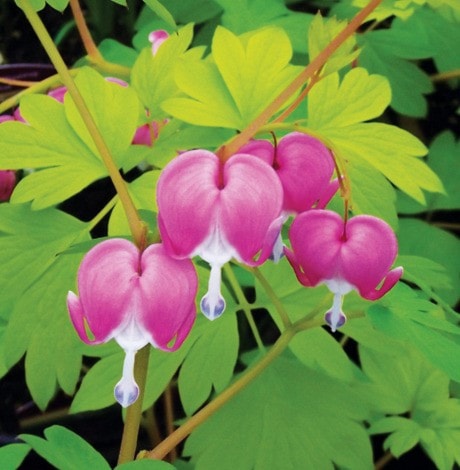Just when you think you’ve memorized all the important plant names, the botanical powers-that-be decide to reclassify on a genetic level, giving us a plethora of new scientific names that few people (including those in the trade) actually use.
Enter Lamprocapnos spectabilis, the new moniker for old-fashioned bleeding heart (Dicentra spectabilis) that I’ve yet to see on any plant tag – so I’ll just stick to the names we both know.
A Victorian garden favourite, Dicentra spectabilis was introduced into western gardens by the plant explorer Robert Fortune in 1847, after trips to China and Japan. The heart-shaped flowers of this species are rose-pink, with a darker reddish protrusion (or ‘drop of blood’) dangling down from the white centre of the bloom – hence the common name bleeding heart.
This species is quite versatile and, over time, forms large multi-stem clumps reaching heights of 1.2m.
A newer gold-leaved cultivar called ‘Gold Heart’ was discovered by Canadian Nori Pope at Hadspen Garden in Somerset England. While the flower colour is much the same, the bright iridescent yellow foliage really gleams in those shaded corners and if it catches just a hint of sun, it literally lights right up.
Last year’s big introduction was Dicentra spectabilis Valentine (syn. ‘Hordival’), which brought us cherry red and white blooms along with contrasting burgundy stems, and as many of you know, those reds can be a difficult find for the woodland garden.
White-flowered bleeding hearts also really stand out well among the muted deep greens of a shaded garden and there are quite a few choices for you Alba enthusiasts.
The tallest of these is Dicentra spectabilis ‘Alba’, an all-white version of traditional bleeding heart with chains of pendulous blooms (April-May) over pale green foliage reaching heights of 75cm. We also have white forms of both eastern (D. eximia ‘Alba’) and western (D. formosa var. alba) bleeding heart that grow 45-60cm high and form dense groundcovers. A few good white hybrids include ‘Aurora’ (greyish-green foliage) and the newer ‘Ivory Hearts’, with long-lasting flowers over finely cut bluish-green foliage.
Our native bleeding heart (Dicentra formosa) is a favourite of hummingbirds and happily self-seeds, forming large colonies – these are quite compatible with taller woodland perennials such as Solomon’s Seal (Polygonatum) and larger Hosta such as ‘Sum and Substance’. A darker purplish-red cultivar (‘Bacchanal’) is also available and Canadian species are an intricate part of the lineage of the new, longer blooming (from late spring to midsummer) Fern-Leaf bleeding hearts, which include ‘Burning Hearts’ (intricate deep red flowers over bluish-grey fern-like foliage), ‘Candy Hearts’ (rose-pink blooms over bluish-green foliage) and ‘King of Hearts’ (a floriferous deep rose-pink cultivar).
Caring for bleeding hearts is relatively easy and consists of the following: top-dress with compost in early spring (before new growth is initiated); deadhead the spent blooms (this will prolong the flowering period); keep them evenly watered when in leaf (this will prevent premature summer dormancy); and divide the plants every three to four years to maintain vigour.
All bleeding hearts enjoy shade, but will tolerate morning to early evening sun here on the coast. I’ve even seen some spectacular specimens of Dicentra spectabilis grown in full sun in sheltered sites (no drying winds) with even soil moisture.
All bleeding hearts are generally quite cold hardy (between Zones 3 to 4), so they will work well in containers and can be grown in higher elevations or that cottage in the interior.
Mike Lascelle is a local nursery manager and gardening author (hebe_acer@hotmail.com).
